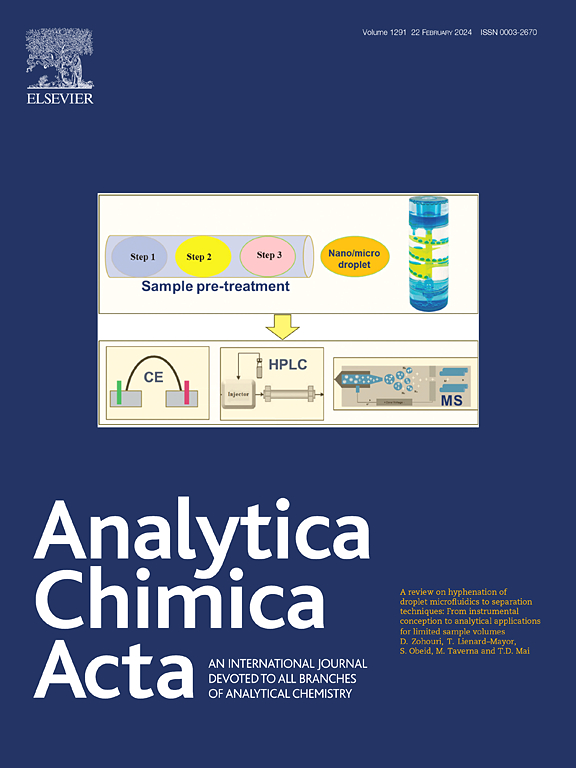基于酶抑制的有机胺检测高分子光子晶体平台
IF 6
2区 化学
Q1 CHEMISTRY, ANALYTICAL
引用次数: 0
摘要
工业中有机胺的广泛使用引起了严重的环境问题。传统的检测方法,如色谱法,精度高,但成本高,耗时长,需要专门的设备,限制了它们在常规环境监测中的实际应用。这强调了对便携式、经济高效和用户友好的检测技术的需求。结果设计并制备了一种基于反蛋白石聚合物光子晶体(IOPPCs)的有机胺检测传感器。通过整合脲酶催化反应,IOPPCs在不同胺溶液中表现出显著的结构颜色变化。由于尿素酶催化的尿素水解直接影响环境的pH值,因此具有大表面积的ioppc呈现红移反射峰,从而增强了有机胺的定性和半定量检测。值得注意的是,在1×10-9 mol L-1到1×10-7 mol L-1的低浓度范围内,对乙二胺的选择性检测已经实现。为了增强用户的可访问性,该平台结合了现有的移动应用程序,将结构颜色数据转换为定量信息。意义与新颖性该传感器平台具有优异的抗干扰性、强适用性和可重复使用性,突出了其实时、现场检测有机胺的潜力。这对环境和公共卫生监测具有重要的实际意义。本文章由计算机程序翻译,如有差异,请以英文原文为准。


Polymeric photonic crystal platform for organic amines detection based on enzyme inhibition
Background
The extensive use of organic amines in industries has led to significant environmental concerns. Traditional detection methods, such as chromatography, are highly accurate but costly, time-consuming, and require specialized equipment, limiting their practical use in routine environmental monitoring. This underscores the need for portable, cost-effective, and user-friendly detection technologies.
Results
In this study, a novel sensor for organic amine detection based on inverse opal polymer photonic crystals (IOPPCs) has been facile designed and fabricated. By integrating urease-catalyzed reactions, the IOPPCs exhibited notable structural color changes in response to different amine solutions. Since the urease-catalyzed hydrolysis of urea directly affects the pH of the environment, the IOPPCs with a large surface area exhibit redshifted reflection peaks, enabling enhanced qualitative and semi-quantitative detection of organic amines. Notably, selective detection of ethylenediamine has been achieved at the low concentration from 1 × 10−9 mol L−1 to 1 × 10−7 mol L−1. To enhance user accessibility, the platform incorporates an existing mobile app to convert the structural color data into quantitative information.
Significance and novelty
The sensor platform demonstrates excellent resistance to interference, strong applicability, and reusability, highlighting its potential for real-time, on-site detection of organic amines. This has significant practical implications for environmental and public health monitoring.
求助全文
通过发布文献求助,成功后即可免费获取论文全文。
去求助
来源期刊

Analytica Chimica Acta
化学-分析化学
CiteScore
10.40
自引率
6.50%
发文量
1081
审稿时长
38 days
期刊介绍:
Analytica Chimica Acta has an open access mirror journal Analytica Chimica Acta: X, sharing the same aims and scope, editorial team, submission system and rigorous peer review.
Analytica Chimica Acta provides a forum for the rapid publication of original research, and critical, comprehensive reviews dealing with all aspects of fundamental and applied modern analytical chemistry. The journal welcomes the submission of research papers which report studies concerning the development of new and significant analytical methodologies. In determining the suitability of submitted articles for publication, particular scrutiny will be placed on the degree of novelty and impact of the research and the extent to which it adds to the existing body of knowledge in analytical chemistry.
 求助内容:
求助内容: 应助结果提醒方式:
应助结果提醒方式:


